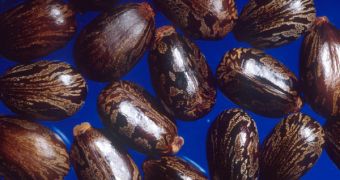You might have heard on the television more than once about the assassination of the Bulgarian dissident Gerogi Markov with the help of a device hidden inside an umbrella, which fired a small pellet containing ricin into his leg. But what is ricin and why is it so deadly? It is a potent protein toxin extracted from the castor bean (Ricinus communis), which in quantities equal or higher than 500 micrograms becomes deadly to the human body.
Exposure to ricin, be it through inhalation, injection or ingestion, triggers the inhibition of protein synthesis inside the body. After ricin finds its way into the body it determines the onset of a severe diarrhea, followed by death as a result of the shock. Currently, there is no known antidote to ricin poisoning, although the US Army has created a vaccine against it. The ingestion of castor beans, from which ricin is extracted, is usually not lethal, mostly because this plant is so rare, although more than eight beans are able to deliver a toxic dose if swallowed.
Contact with the skin and eyes generally causes pain, but it is not fatal. The symptoms of intoxication appear about 12 hours after the exposure has taken place, and include coughing, fever and stomach pains. In the case of ingestion, the symptoms appear after about five hours in the form of stomach aches, bloody diarrhea, vomiting and gastroenteritis. Five days later, the victim may also experience dehydration and low blood pressure.
Ricin making its way into the body through the airwaves is most likely to result in severe lung damage, seizures and even central nervous system problem. Death follows in the first five days after the exposure, although if the dose is not fatal the victim is most likely to survive.
Ricin was considered as a possible application during the First World War, as a biological weapon, but it was never used because the means to deliver it violated international conventions. Toxic dust containing ricin, which was investigated by the US roughly during the same time period, never even left the concept stage.
In World War II ricin was studied as a potential biological weapon by both the US and Canada, but again the projects were not materialized. Ricin was also used in assassinations and assassination attempts due to its potency, being employed by the KGB, in some cases even outside the borders of the Soviet bloc, as in the case of Gerogi Markov.
Currently, ricin is studied as a possible means to target and destroy cancer cells, since its modification could reduce the toxicity to the human body but not to cancer cells.

 14 DAY TRIAL //
14 DAY TRIAL //